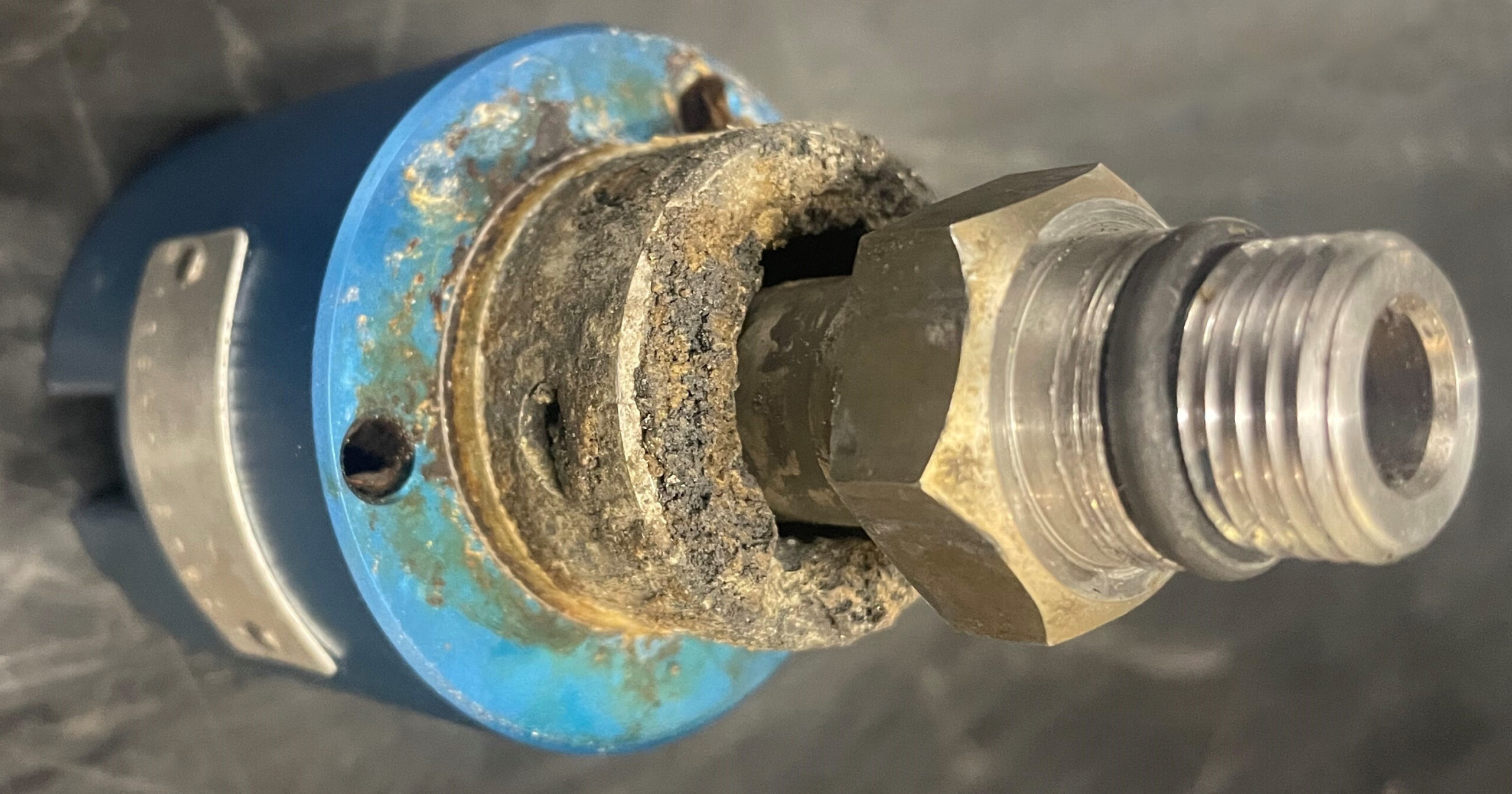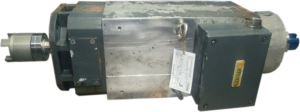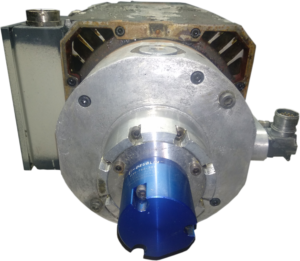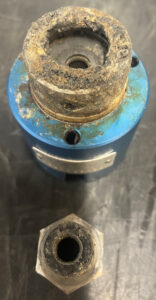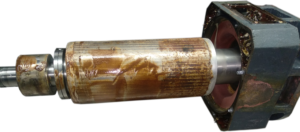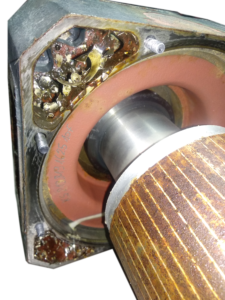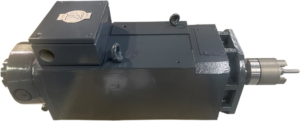The rotary joint that some electrospindles have has a very strict preventive maintenance. This type of gasket is carried by engines such as the one we are going to see in this article. It is a FRANZ KESSLER brand electrospindle, specifically the DMO112.AM.4.AFS-C4 model. These teams are usually mounted on Chiron brand metal machining centers.
The rotary joint problem.
These motors are usually mounted vertically inside machining centers. The rotary joint is mounted on the upper part of the electrospindle, depending on its working position. Its mission is to provide through it the cooling water of the tool. And it has a specific number of hours of use, which if we do not take into account through preventive maintenance of this joint, we will cause the failure and this will result in the entry of water into the electrospindle. This is the most typical breakdown in this type of engine. If the maintenance of the rotary union is not carried out at the appropriate working hours, we will have the failure assured.
The operation of the rotating union.
In the image of the previous point, we can see a blue capsule in the center of the electrospindle. This is the rotary joint. It is made up of two pieces, in the image on the right we have them disassembled and we see how they are clearly damaged by rust. Now we will describe how this situation has come about.
Some rotating unions can mount a bearing, although in this case it is a two-piece assembly.
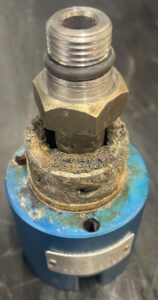 Let’s first understand how this board works. In the image on the right we see two pieces, the blue piece is fixed and fastened to the electrospindle casing, while the lower piece is integral with the rotor shaft. Both pieces come into contact through a graphite gasket closure (we see them assembled in the image on the left).
Let’s first understand how this board works. In the image on the right we see two pieces, the blue piece is fixed and fastened to the electrospindle casing, while the lower piece is integral with the rotor shaft. Both pieces come into contact through a graphite gasket closure (we see them assembled in the image on the left).
The fixed part has a spring that, when the pressure enters, pushes and makes the two graphite faces come into contact. Specifically, they are the one that is mounted on the fixed part and the one that is integral with the rotor that is in permanent rotation. On the other hand, the water would pass through the interior of the two pieces, but it would not come out due to the action of the graphite gasket. When the pressure disappears, it returns backwards due to the effect of the spring and the two pieces are separated, since if they rubbed against each other dry they would be damaged.
Filtration of the cooling liquid.
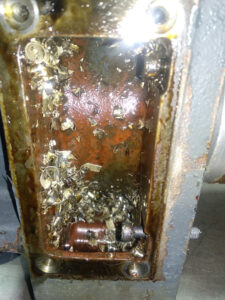 The cooling liquid that is the one that passes through the joint must be clean and without traces of metal chips or remains of the work of the tool. It must also work at the pressure indicated by the manufacturer for the spring to act correctly.
The cooling liquid that is the one that passes through the joint must be clean and without traces of metal chips or remains of the work of the tool. It must also work at the pressure indicated by the manufacturer for the spring to act correctly.
This cooling liquid must have the characteristics indicated by the manufacturer and the filtering system must guarantee its quality. If filtering fails, the liquid will drag chips and problems begin. Metal remains can be deposited on the graphite faces and prevent total sealing, allowing liquid to pass into the electrospindle.
We see in the image how the remains of chips have a great presence on the outside of the engine. The coolant recirculation system can drag these metal remains as a result of the work of the tool and if the filtering is deficient, the problem will begin.
The failures resulting from this failure, the encoder.
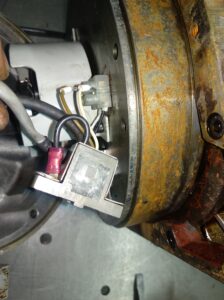
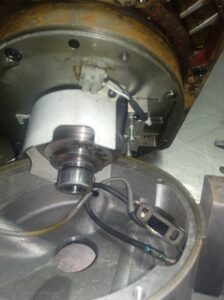 As we said, the most dangerous thing is the seriousness of the breakdowns that it can generate. In the case of the electrospindle that we are commenting on and we use as a model, all the possible damages that a fault like the one we are describing could cause have been produced. When this failure occurs, the first thing that will happen is that the leaking water passes through the encoder and can completely damage it, forcing it to be replaced. We see in the images the oxidation on the surfaces of the encoder.
As we said, the most dangerous thing is the seriousness of the breakdowns that it can generate. In the case of the electrospindle that we are commenting on and we use as a model, all the possible damages that a fault like the one we are describing could cause have been produced. When this failure occurs, the first thing that will happen is that the leaking water passes through the encoder and can completely damage it, forcing it to be replaced. We see in the images the oxidation on the surfaces of the encoder.
More rotor and stator problems.
After the encoder, since the electrospindle is mounted vertically, the water would continue to descend due to the effect of gravity towards the winding, which is the next element. Although the winding in these motors is 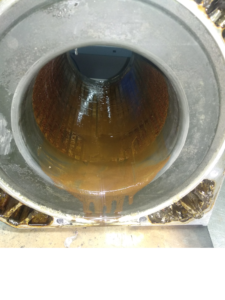 encapsulated, precisely to increase the protection, if the water is in a continuous passage through the winding, in the end it will also damage it.
encapsulated, precisely to increase the protection, if the water is in a continuous passage through the winding, in the end it will also damage it.
Obviously, this continuous circulation of water inside the winding will also affect the rotor. In the images we can see the state of degradation that both the stator and the rotor present. You can clearly see the moisture inside the stator and obvious signs of oxidation on all surfaces.
 The bearings.
The bearings.
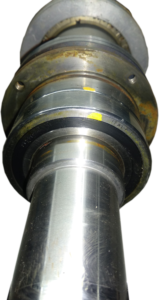 In addition, another problem occurs, as the liquid is permanently entering, the grease is eliminated from the bearings and ends up damaging these elements. In the images we see the clear presence of rust on all parts of the shaft, including the bearings.
In addition, another problem occurs, as the liquid is permanently entering, the grease is eliminated from the bearings and ends up damaging these elements. In the images we see the clear presence of rust on all parts of the shaft, including the bearings.
As the stator winding is encapsulated, the rewinding of this equipment is a very costly breakdown, given that the repair time is very long. In addition to the difficulty involved in this repair.
For most cases, this failure must be solved with at least the replacement of seals and bearings, as well as the replacement of the encoder. But also, as we have already indicated, in the most serious cases it will be necessary to rewind the stator.
Preventive Maintenance.
As you can see, preventive maintenance is more than a possible option. It is a need that we must take care of to avoid greater evils. With proper control of the rotary joint we can avoid many problems and of course, in all cases, with huge savings. These engines present this fault very frequently and in a very high percentage of cases, the reason is always the same: poor preventive maintenance.
Finally the equipment was in perfect condition and ready to return to production, now, it will be necessary to pay attention to the effective working time of the rotating union, but not to go through the same collection of problems.
You can ask us any questions in THIS SAME FORM.

